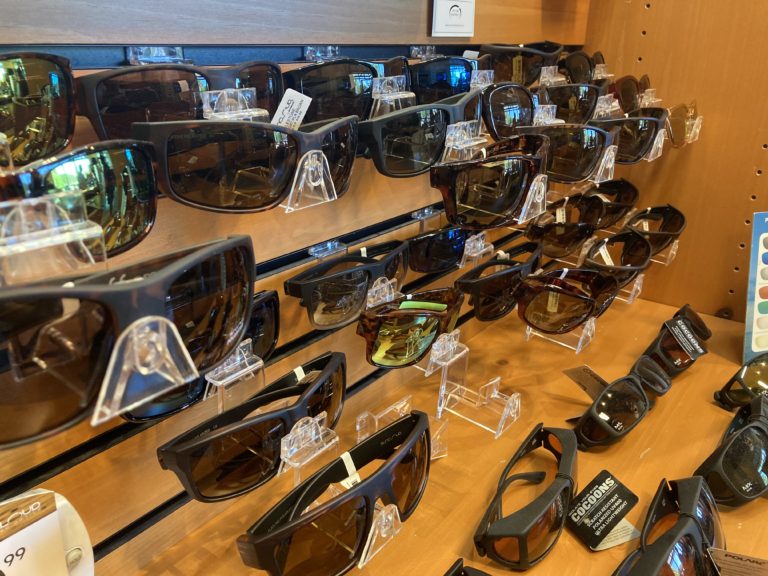
BENEFITS OF USING POLARIZED SUNGLASSES
Polarized sunglasses are not a fashion statement; they are a critical piece of safety equipment as well as one of the greatest fishing tools you own. Investing in a quality pair of polarized sunglasses will offer critical protection against harmful UV rays as well as preventing hooks from making your eye a pin cushion. As anglers, we want to employ every potential advantage we have to give us the best shot at hooking up. Cutting glare is one of those BIG advantages. They will allow you spot fish easier and be visually in touch with every presentation you make. It will also reveal what you’re working with structurally in the water, whether that is avoiding snags or identifying different depths/types of water while allowing you to see your next step, ensuring your boot finds its intended target.
HOW THEY WORK
Polarized lenses are essentially a filter made up of vertical iodine crystals that absorb light waves. Glare on the water is a result of light reflection quickly developing into horizontal concentrations of harmful, ultra-violet rays of light. The retina of the eye is particularly vulnerable to ultraviolet light. Polarized lenses absorb the reflected light and prevent any damage to the eye and allow you to see “into” the water.

POLYCARBONATE vs. GLASS
You should devote just as much thought into picking the right sunglasses for you as you would with a rod, reel or line. Investing in a quality pair of Costa, Smith or SunCloud glasses will not only offer better performance than the ones at the gas station, they will structurally be more durable as well. There are commonly two types of lenses offered, glass or polycarbonate (plastic). Glass lenses provide the best optical quality and will be substantially more scratch resistant. Polycarbonate lenses are lighter than glass, more affordable, and will be less prone to shattering/cracking if dropped or stepped on.
LENS COLOR
Another critical step in choosing the right pair of shades is lens color. The most common lens colors today are gray and brown/amber. Grey lenses will perform the best under the most extreme sunny conditions, like a saltwater flat or even a bright day on Crane Prairie. An amber or brown lens is more versatile in the sense that they will accomplish cutting glare in almost every light condition you might encounter to some degree.
The third option is a yellow lens. Yellow lenses provide the highest light transmission of any lens color and allow the angler to wear his glasses in the early morning and late evening (we’ve heard these are decent times to fish) as well as in severe overcast conditions without the uncomfortably dark tint of grey and brown lenses. Another benefit of a yellow lens is increased contrast on dreary days, where other lenses would leave colors looking washed out and dull. The amber lens is our first choice for this area, as it provides the best performance for every season and in variable light conditions where the angler may encounter direct sunlight, shade, and overcast conditions throughout the course of the day.
Grey lenses are a close second for those really bright summer days. As a guide, I have three pairs with me at all times, one amber and one gray for myself, and an extra set as a backup in case a client needs a pair.

FRAMES AND STYLE
The style of your glasses is a personal choice, seriously, who doesn’t look good in a pair of aviators and a jean jacket? Style points aside, the frame design deserves some consideration. First priority should be comfort. They should fit snugly around your face and not slide off your nose while moving around. Frames that employ the “wrap around” design will offer the most protection and least amount of light penetration, giving you the clearest view. Nose bridges should be comfy too. If you decide to pull the trigger on a pair of quality shades, you need to buy a lanyard or strap. The last thing you want to happen is to be wading, fighting a fish, or riding in a boat, and have them fall off and disappear into the depths. A lanyard will also keep them tight against your face.
Hopefully this clears up any questions on Polarized sunglasses and allows you to wade safer, see clearer and catch more fish on your next trip! Come into the shop and try on the best from Costa, Smith and SunCloud.

